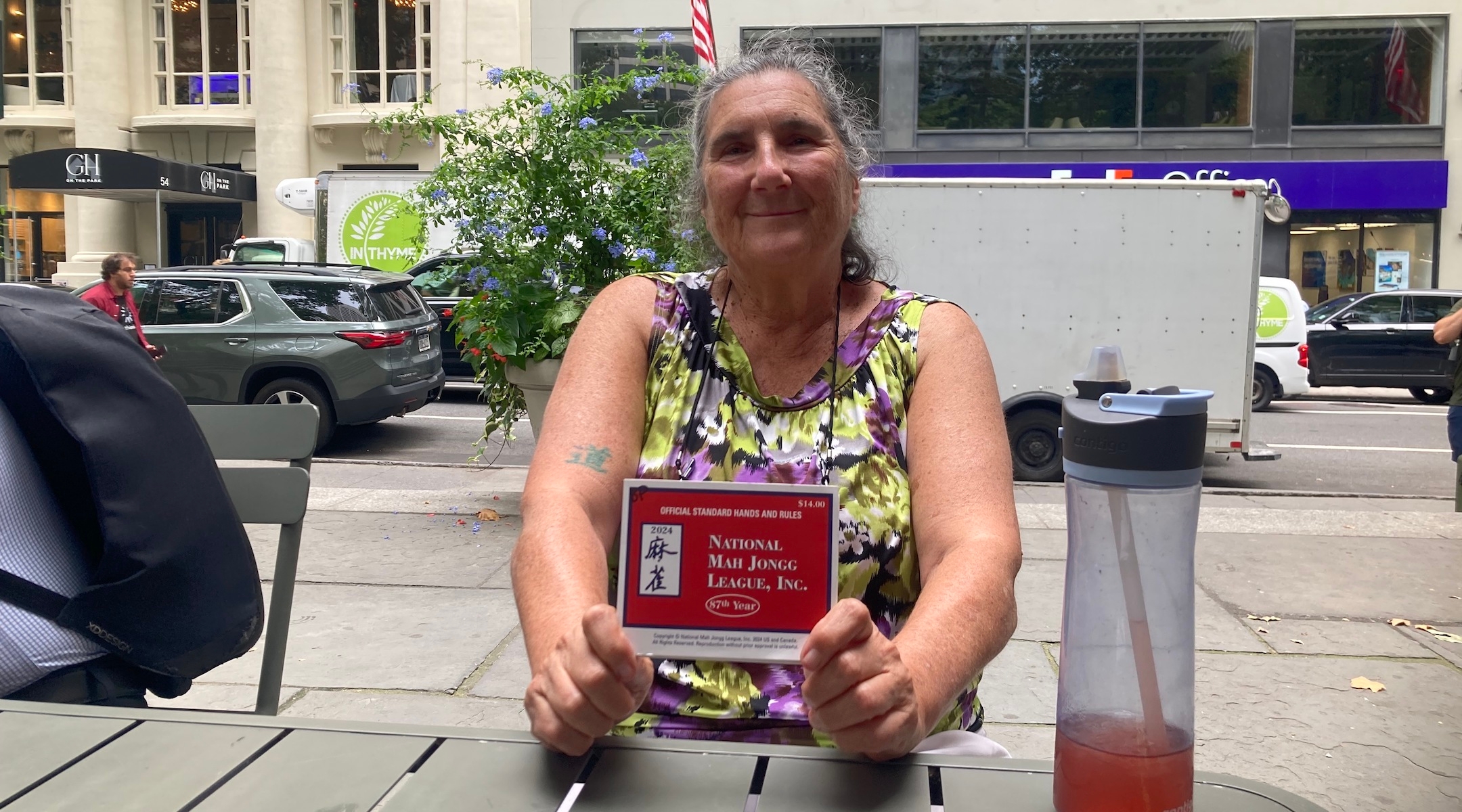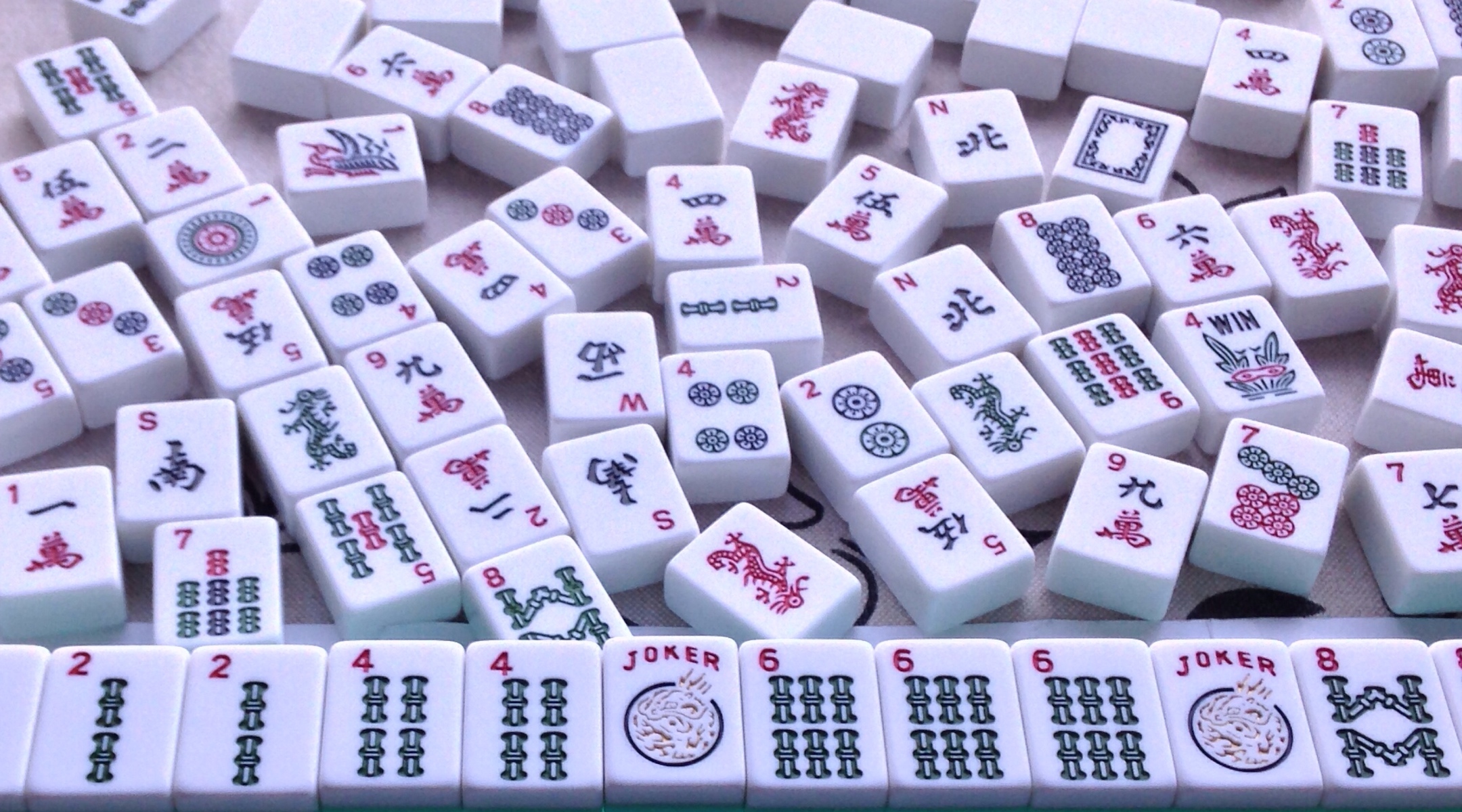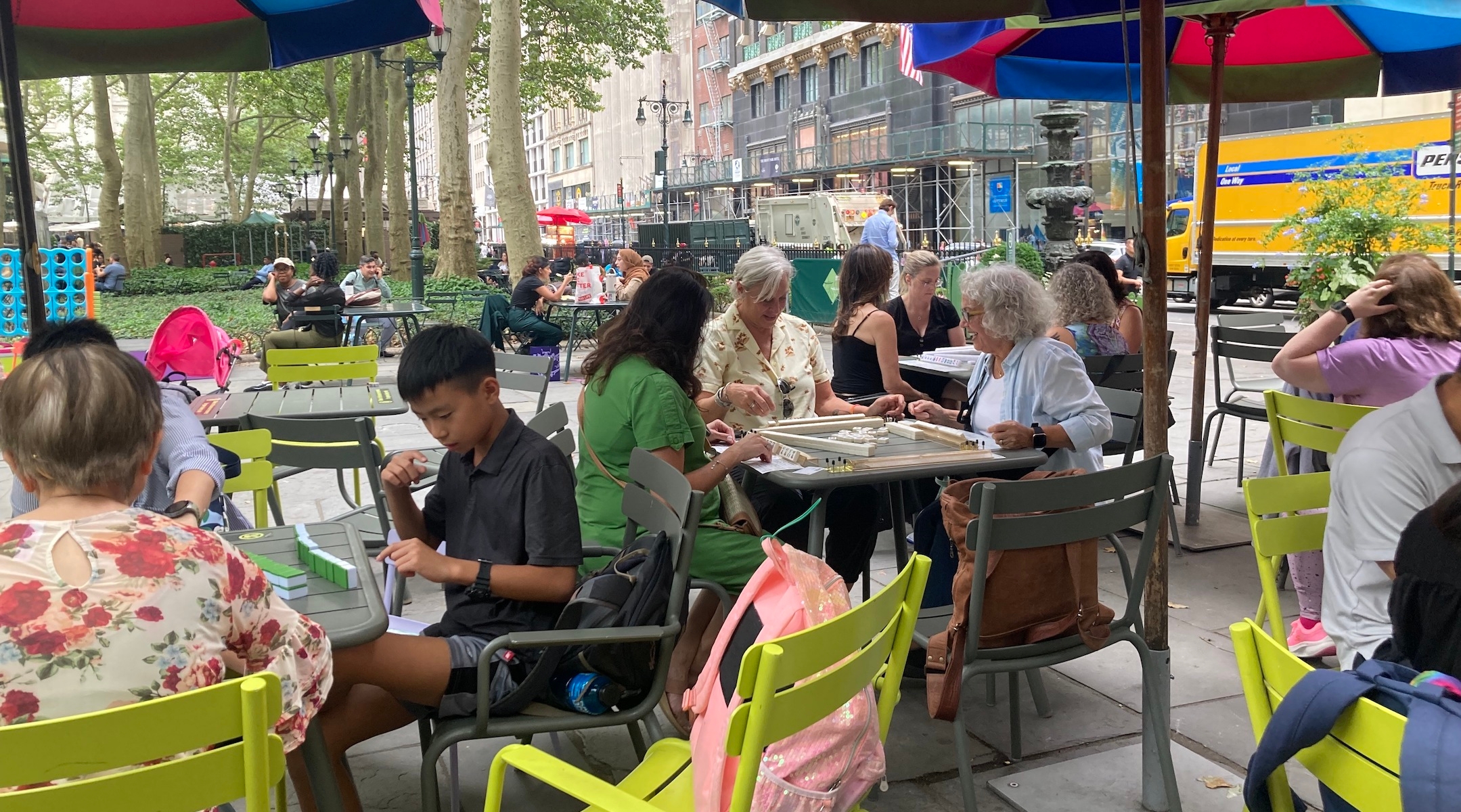It’s a steamy Thursday afternoon in New York City and, despite the humidity, Bryant Park is abuzz with activity: Office workers eat their lunches at bistro tables scattered about the park, tired tourists sprawl across the grass, a crowd gathers around a piano to sing show tunes and teens challenge one another in ping-pong.
In a shady corner of the park, about 30 people — mostly but not all women — are seated at tables in groups of four, smiling, chatting and calling out phrases like “Two bam!” and “Eight dot!”
Welcome to the Mah Jongg Social, a weekly gathering of mah jongg aficionados who have been meeting at Bryant Park in Midtown every summer since 2012. The social is organized and hosted by Linda Fisher, a seasoned mah jongg teacher who runs a popular blog dedicated to the game. Every summer Thursday, some 30 to 50 people, depending on the weather, gather from 3 p.m to 7 p.m. to play the tile-based game with roots in 19th-century China that was then popularized by American Jews in the mid-20th century.
“It’s such a pleasure,” said Fisher, 72, who lives in Forest Hills, Queens, but grew up playing with members of her extended Jewish family in the Bronx. “The thing I like most about it, we get people from all over the world.”
When the social began 12 years ago, the park owned three mah jongg sets. Now, Fisher said, there are 10 sets available, and the park buys new rule cards from the National Mah Jongg League every year. (There’s also one Asian set available, Fisher explained, as the American and Asian versions of the game are slightly different.) “For me, the best part is meeting people from all over the place,” she said. “We play the same version, we all connect and people make friends.”
One such player is Shira Grunstein, who’s originally from New Jersey but now lives in Israel. Grunstein, who learned to play 10 years ago, was thrilled to discover a regular game at Bryant Park while on vacation. “I love the strategy,” said Grunstein, 48, who typically plays two times a week at home. “I love to play games but I also love hanging out with my girls — it combines two of my favorite things.”
Life in Israel is not easy at the moment, Grunstein points out, especially as she has two children serving in the IDF. But mah jongg “is definitely a way to get away from it all,” she said. “It took a while for us to get back into the game after Oct. 7, but it’s been a good distraction.”
Though the game has deep roots in China and was briefly a fad in the United States in the 1920s, mah jongg (which is also spelled mahjong) is often associated with Jewish women. Jewish women were the creators of the National Mah Jongg League in 1937, and helped promote the game through their informal networks. After World War II, the game was played wherever Jewish women were enjoying their leisure time, from living rooms in the burgeoning suburbs to vacation spots in the Catskills.
The league “to this day strives to maintain consistency in the game,” according to My Jewish Learning. “Each year the League issues a card listing winning combinations of tiles (which change every year) and standard regulations. This stability helped the game to survive.”

Mah jongg expert and teacher Linda Fisher of Forest Hills has been hosting the meetup since 2012. (Lisa Keys)
This Americanized version of the game was — and, to some extent, still is — a popular way to fundraise for Jewish and other charitable causes. As Fisher points out, the league is itself a philanthropic organization; in addition to being “the arbitrator for everything that relates to American Maajh,” according to its web site, the league donates a portion of the proceeds of the official rule card sales each year to charitable organizations. A partial list of charities supported by the league on its website features several Jewish groups, including Hadassah, ORT America and Brandeis University.
“It was a very Jewish thing for a long time,” Fisher said. “Over time, it kind of spread all over. Now it’s still thought of as ‘Jewish mah jongg,’ but there are people all over the country playing [it] who are not Jewish.”
One such player last Thursday was Lorie Honor, a 62-year-old Italian-American from Staten Island who said she plays mah jongg every day, both online and in person. She doesn’t come to the Bryant Park meetup every week, but, she said, “it’s on my calendar.”
“The combination of the social and the brain activity — it’s great,” said Honor, emphasizing how games like mah jongg can help stave off dementia. “It’s a very strategic game. It’s complicated at first but, like, I’ve memorized the whole card.”
Honor’s tablemate, Hilda Santiago, a retired New York City school teacher, said she learned to play two years ago by taking courses offered by the teachers’ union. She was motivated to learn in order to play with her daughter — who herself had learned to play with her sister-in-law at synagogue. “I come here to play all summer,” she said.
Santiago, 77, isn’t Jewish. But is her daughter? After all, she learned the game at synagogue. “No,” Santiago said. “But she thinks she is.”
Sandwiched between Fifth and Sixth Avenues and stretching from 40th Street to 42nd Street, Bryant Park touts itself as one of the busiest public spaces in the world. That’s a relatively recent phenomenon: After years of neglect, the Bryant Park Corporation was established in 1980 in order to transform the 9.6-acre square from “a sequestered haven for drug dealers into one of New York City’s busiest outdoor public spaces,” Bruce Weber wrote in the New York Times in 1995.
These days, Bryant Park has a packed schedule of free activities: yoga, shuffleboard, magic shows, juggling classes. Board games from Bananagrams to Yahtzee are free to borrow and play at the park every day from 11 a.m to 7 p.m. from April through October. Though mah jongg sets are available during those regular hours, it’s only one of two games — the other being Settlers of Catan — that has a dedicated weekly time slot.
“Mah jongg has a bit of a crowd,” said a Bryant Park employee who asked to remain anonymous, citing lack of permission to talk to the press. “Everyone is constantly asking about the mah jongg social.”
Snowbird Carol Blatt, 69, who splits her time between New York and The Villages in Florida, is a regular at the mah jongg social. “God bless Linda,” said Blatt, whose mother taught her to play when she was in third grade.
Blatt loves “the camaraderie, talking to people,” she said about the gathering. “The game is good for your brain.”

A closeup of a mah jongg set. (Scott Schiller/Flickr)
As for Fisher, who grew up in the Bronx near Yankee Stadium, her great-aunt taught her to play. “She was a mah jongg maven in the Bronx – she went to tournaments, she went on [mah jongg] cruises, she recruited everyone and taught everyone to play,” she said.
“I’d sleep over at her house on Fridays — I would hear them playing mah jongg all night. I’d hear the tiles, I’d help get the candy ready, all that stuff,” she said. “When I got older I went with her to tournaments, we played with neighbors.”
Mah jongg “was always very comforting,” Fisher said. “It was challenging but every hand was different. It’s always kind of new. Then the card changes every year. New hands are always coming out that are new and interesting, and then the social part of it — you just meet people.”
Indeed, the crowd at the park on Thursday appeared to be a mix of old friends and new, though the camaraderie among the players was palpable. Tablemates Grunstein and Honor were so in sync, for example, that this reporter assumed they had known each other for years when, in fact, they had just met earlier that afternoon.
When asked about the enduring appeal of mah jongg among members of the Jewish community, the pair shared an answer. “Julia Roberts plays [mah jongg],” Grunstein responded. “She’s not Jewish.”
“She has a regular game in Texas on Tuesdays,” Honor added. “She’s also given me a good tip: She said, ‘Mah jongg is trying to make order out of chaos.’ This gives me hope – this is chaos and I’m trying to make order out of it. It really applies to life.”
The New York Jewish Week brings you the stories behind the headlines, keeping you connected to Jewish life in New York. Help sustain the reporting you trust by donating today.





